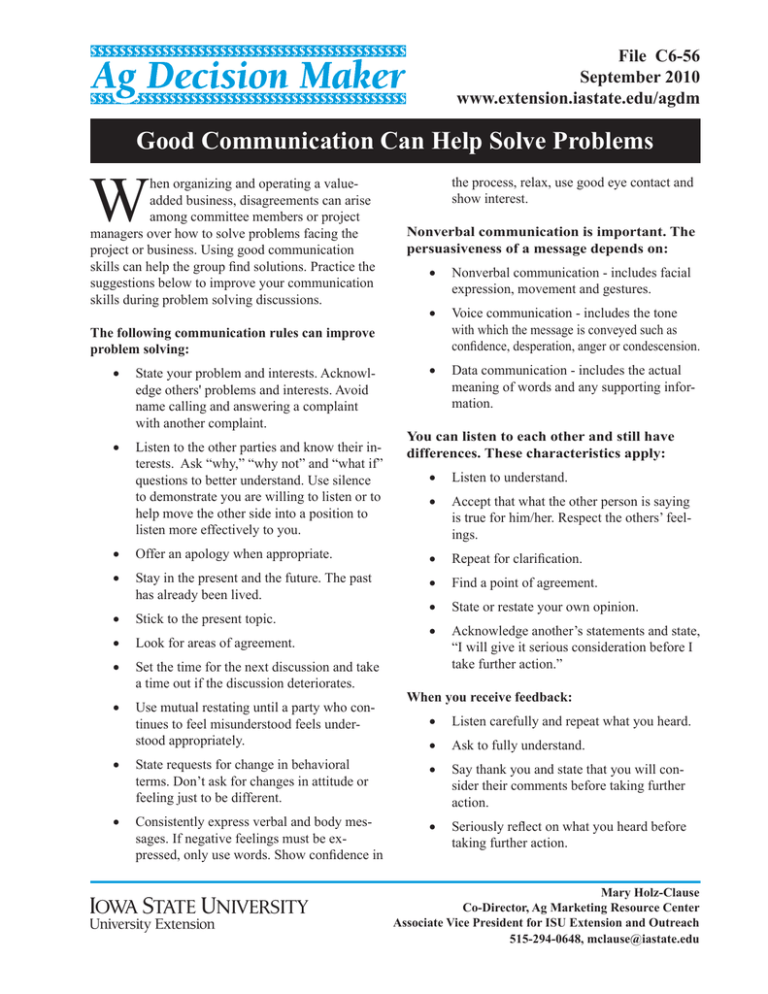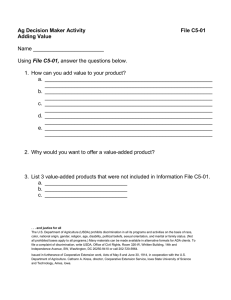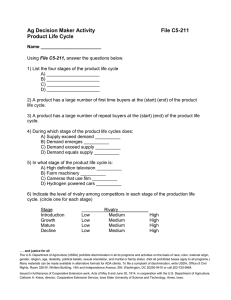Good Communication Can Help Solve Problems
advertisement

File C6-56 September 2010 www.extension.iastate.edu/agdm Good Communication Can Help Solve Problems W hen organizing and operating a valueadded business, disagreements can arise among committee members or project managers over how to solve problems facing the project or business. Using good communication skills can help the group find solutions. Practice the suggestions below to improve your communication skills during problem solving discussions. The following communication rules can improve problem solving: State your problem and interests. Acknowledge others' problems and interests. Avoid name calling and answering a complaint with another complaint. Listen to the other parties and know their interests. Ask “why,” “why not” and “what if” questions to better understand. Use silence to demonstrate you are willing to listen or to help move the other side into a position to listen more effectively to you. the process, relax, use good eye contact and show interest. Nonverbal communication is important. The persuasiveness of a message depends on: Nonverbal communication - includes facial expression, movement and gestures. Voice communication - includes the tone with which the message is conveyed such as confidence, desperation, anger or condescension. Data communication - includes the actual meaning of words and any supporting information. You can listen to each other and still have differences. These characteristics apply: Listen to understand. Accept that what the other person is saying is true for him/her. Respect the others’ feelings. Offer an apology when appropriate. Repeat for clarification. Stay in the present and the future. The past has already been lived. Find a point of agreement. Stick to the present topic. Look for areas of agreement. Set the time for the next discussion and take a time out if the discussion deteriorates. Use mutual restating until a party who continues to feel misunderstood feels understood appropriately. State or restate your own opinion. Acknowledge another’s statements and state, “I will give it serious consideration before I take further action.” When you receive feedback: Listen carefully and repeat what you heard. Ask to fully understand. State requests for change in behavioral terms. Don’t ask for changes in attitude or feeling just to be different. Say thank you and state that you will consider their comments before taking further action. Consistently express verbal and body messages. If negative feelings must be expressed, only use words. Show confidence in Seriously reflect on what you heard before taking further action. Mary Holz-Clause Co-Director, Ag Marketing Resource Center Associate Vice President for ISU Extension and Outreach 515-294-0648, mclause@iastate.edu Page 2 File C6-56 When you give feedback: Separate the behavior from the person. Be specific and factual about behaviors. Avoid value judgments and demands for a change in attitude or emotion. Describe how you feel. Describe how this affected you. Be sensitive and respectful. Present this feedback as a gift, then leave it behind. . . . and justice for all The U.S. Department of Agriculture (USDA) prohibits discrimination in all its programs and activities on the basis of race, color, national origin, gender, religion, age, disability, political beliefs, sexual orientation, and marital or family status. (Not all prohibited bases apply to all programs.) Many materials can be made available in alternative formats for ADA clients. To file a complaint of discrimination, write USDA, Office of Civil Rights, Room 326-W, Whitten Building, 14th and Independence Avenue, SW, Washington, DC 20250-9410 or call 202-720-5964. Issued in furtherance of Cooperative Extension work, Acts of May 8 and June 30, 1914, in cooperation with the U.S. Department of Agriculture. Gerald A. Miller, interim director, Cooperative Extension Service, Iowa State University of Science and Technology, Ames, Iowa.


